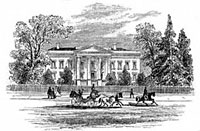Most of the places Mr. Lincoln visited had military or political significance. Even his recreational carriage rides in the late afternoon often stopped at Union army camps and hospitals. Although Mrs. Lincoln usually accompanied him on these excursions, she made her own separate stops at the hospitals.
Mr. Lincoln often mixed his diversions with business. A walk on the South Lawn might lead to weapons testing. A walk across Lafayette Park would lead to discussions with Secretary of State William Seward at his fireside. A drive back from the Soldiers Home might lead to a stop at Secretary of War Edwin Stanton’s home for a brief update. Fortunately for the President, he was surrounded by park land — Lafayette Park, the South Lawn, the Ellipse and Treasury Park. In good weather, some of these venues became the site of Marine Band concerts that the President enjoyed.
But there was also a certain practicality in living on the city’s main street. Journalist Noah Brooks recalled: “One summer morning, passing by the White House at an early hour, I saw the President standing at the gate-way, looking anxiously down the street; and, in reply to a salutation, he said, ‘Good-morning, good-morning! I am looking for a news-boy; when you get to that corner I wish you would start one up this way.'”1
But because of their proximity to the White House, there was also a good chance that the President might be interrupted on any jaunt in or around Pennsylvania Avenue. For real recreation, the President frequently escaped to the much more distant Navy Yard, where he could arrange a cruise on the Potomac or a trip to the war front. Provost Marshall William E. Doster recalled “One day, Major Biddle, in charge of the mounted patrol, riding up Pennsylvania Avenue, met two officers with a civilian between them, all mounted, and, as was his duty, asked for their passes. The party rode on, taking no notice of Biddle. ‘Show your passes,’ cried Biddle, ‘or I’ll arrest you.’ The party halted and the civilian said: ‘It’s all right, Lieutenant; these officers are going with me across the river.’ ‘And who the deuce may you be?’ said Biddle. ‘Oh, I am Mr. Lincoln, the President of the United States.’ Biddle bowed in disgust, and explained to me he had taken Lincoln for a Maryland farmer.”2
There was a downside to the location as well, noted historian Jean Baker: “For the President’s House had been built near the Potomac flats and the fetid Washington Canal, which was responsibile for the noxious air that supposedly struck down District residents every summer. At the foot of the President’s Par, another marsh, once an outlet for sewerage, offered up unpleasant scents. When the breeze came from the southeast, suffocating odors wafted into the presidential quarters, but when the wind shifted, the smell was arguably worse. Ten blocks north was the commons where carts dumped the city’s night soil.”3
For ordinary citizens, Pennsylvania Avenue itself could be the source of recreation. A London journalist wrote in 1863 that Pennsylvania Avenue “is wider than Broadway of New York, and generally full of life and motion. In winter, when Congress is in session, it has its ebbs and flows like the main artery of Manhattan Island, the crowd tending downward until the after part of the day, and then returning. The Avenue begins to wear the marks of metropolitan life. There are soap-venders on the corners with patent soaps warranted to remove grease-spots the most tenacious, in an amazingly short space of time. The man with the artificial bugs, attached to elastic strings, swinging up and down in a fashion altogether inviting to the juvenile mind, seems to do a thriving business. The candy-men are present in goodly numbers, with their little stands, on which are displayed huge rocks of the variegated article, from which pieces are chipped off according to the demand. The Lazaroni seem to find themselves as much at home here in roasting their chestnuts, as if the operation were going on under an Italian sky. The men with the telescopes at so much a sight, and the proprietors of lung-testing machines, who ask you if you ‘won’t take a blow to see wot kind of a chist you’ve got,’ have evidently become citizens of the place. The cosmopolitan organ-grinders are at the corners and up the bye-streets, playing the old plaintive tunes as familiar to the inhabitants of the Old as the New World, peering down the areas in quest of the bounties of Bridget, a looking upward with that face which is always pensive, to the windows for the pennies which the little folk are wont to bestow.”4
Footnotes
- David Herbert Donald, Lincoln at Home, pp. 8-9.
- Ronald D. Rietveld, “The Lincoln White House Community,” The Journal of the Abraham Lincoln Association, p. 26.
- William Seale, The President’s House: A History, p. 385.
- Rietveld, “The Lincoln White House Community,” The Journal of the Abraham Lincoln Association, p. 27.












